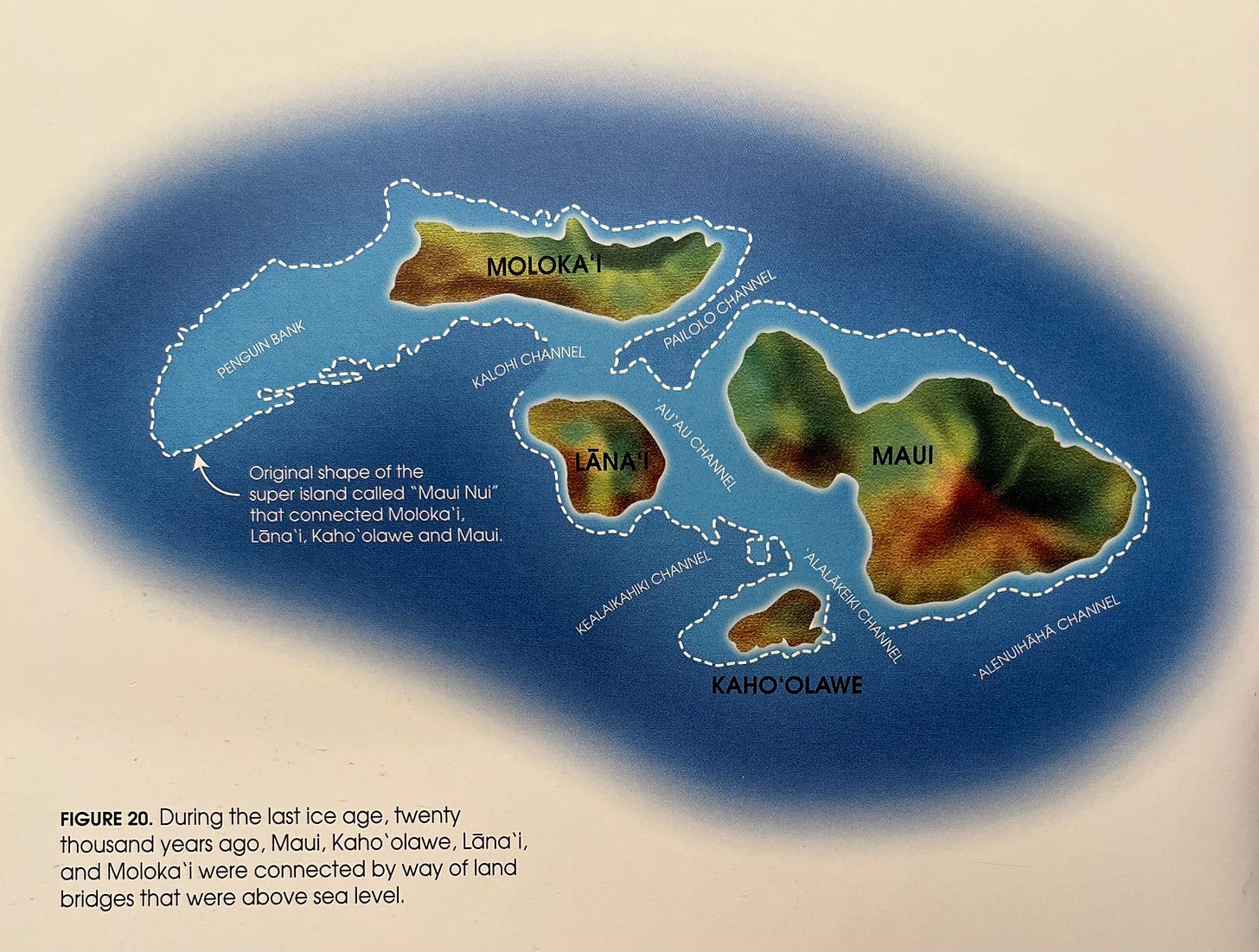Our Naturally Changing Planet
“In the last two million years, sea level has fluctuated up and down about twenty times and by as much as four hundred feet” and we survived.
Changes in historical sea level have also played an extremely important role in eroding, cutting, and shaping the shorelines of the major Hawaiian Islands.
In the Northwestern Hawaiian Islands, the effects of wave cutting and erosion on atolls and submerged banks have been even greater, as we will see in the next chapter. To fully appreciate the impacts of sea level, it is first necessary to know that in the last two million years, during the Pleistocene ice ages, sea level has fluctuated up and down about twenty times and by as much as four hundred feet. Presently we are in a warm period, or interglacial period, and sea level is at a peak elevation, but during the glacial maximum of a typical ice age, a four-hundred-foot lowering of sea level would not be unusual. During such times, the shorelines of the islands would have existed at locations that are four hundred feet deeper than sea level today. Every feature we know on the coastlines of today, like surf sites, coves, rocky points, or bays would have been high and dry. For example, during the last ice age twenty-one thousand years ago, Kane'ohe Bay was a dusty plain almost four hundred feet above the shoreline.
Also back then, the islands of Maui, Lana'i, Kaho'olawe, and Moloka'i would have been connected in one super island called Maui Nui (figure 20).
In contrast to how a lower sea level changed the Hawaiian Islands, we might also consider conditions that existed in the recent past when sea level was higher, as it was during the last interglacial warm period about one hundred twenty-five thousand years ago. At that time, sea level is thought to have been about twenty feet higher than it is today. Much of the evidence for this condition comes from O'ahu, where coral reefs are found all around the island on lowland plains, particularly on the leeward coast (figure 21).
That is from In The Beginning: Archipelago, The Origin And Discovery Of The Hawaiian Islands by Dr. Richard W. Grigg.1


Let’s summarize and think here a bit.
Very gradually, over long time periods, the sea level rises and falls in relation to earth’s naturally changing climate. By how much and over what time period are we talking?
“In the last two million years, during the Pleistocene ice ages, sea level has fluctuated up and down about twenty times and by as much as four hundred feet.”
Let’s do some simple arithmetic: 2,000,000 years divided by 20 equals 100,000 years. So, ocean level naturally varies by as much as 400 feet every 100,000 years.
Earth has experienced many “ice ages.” What is an ice age?
This excerpt only informs us that “during the glacial maximum of a typical ice age, a four-hundred-foot lowering of sea level would not be unusual.”
Presently we are in a warm period, or interglacial period. When was the last interglacial period?
“During the last interglacial warm period about one hundred twenty-five thousand years ago....” What happened to sea level during the last interglacial?
During the last interglacial warm period, “sea level is thought to have been about twenty feet higher than it is today.” What leads us to believe this?
The remains of coral reefs (shown in light brown) in Figure 21, lead us to believe that the ocean was once 20 feet higher.
What are some alternative explanations for the remains of coral reefs being 20 feet above sea level? How else could those remains have gotten there?
Other questions? Comments?
Quiz:
What evidence does this author likely use to support his claim that ocean level was 400 feet lower? (I say likely because this evidence isn’t explicitly stated in this excerpt).
Questions to ponder:
What are some possible causes of earth’s natural climate variation?
What would cause ocean level to change by 400 feet?
If you’d like to see more posts on geology and earth science, let me know.
Dr. Richard W. Grigg is Professor Emeritus of Oceanography at the University of Hawaii where he is internationally known for his research on the ecology and paleoceanography of reef-building corals in Hawaii and the Pacific. His research on the history of the Hawaiian Archipelago and the Darwin Point, illuminating why islands drown at the northwestern end of the Hawaiian Islands, is considered a milestone in the field. Richard Grigg is also known as the world's leading authority on precious coral ecology. He has published over fifty scientific papers on this subject alone and has been active in this field of research for over forty years. Early in his career, Dr. Grigg was an aquanaut in the US Navy project SEALAB II, where he spent fifteen days living under the sea at a depth of 205 feet. Dr. Grigg was recently awarded the National Academy of Underwater Arts and Science's Lifetime Achievement Award for underwater research.
Dr. Grigg, also known as Ricky Grigg, was a pioneer of big wave surfing in Hawaii in the 1950s and 60s and has written several popular books on surfing including Big Surf, Deep Dives and the Islands, Surf Science and Surfer in Hawaii.
In 1967, Grigg won the International Duke Kahanamoku Invitational Surfing Contest at Sunset Beach, Hawaii in 18 foot surf. At the time, the 'Duke' was considered the World Surfing Championship.





I love all things Hawaii! 🌸🌸🌸it is my dream to buy property on one of the islands and live out my old age there and most likely be buried there. They are magical lands. Nothing else like it on Earth. Wonderful summary of the geology of the islands. I have not dived into this knowledge yet.